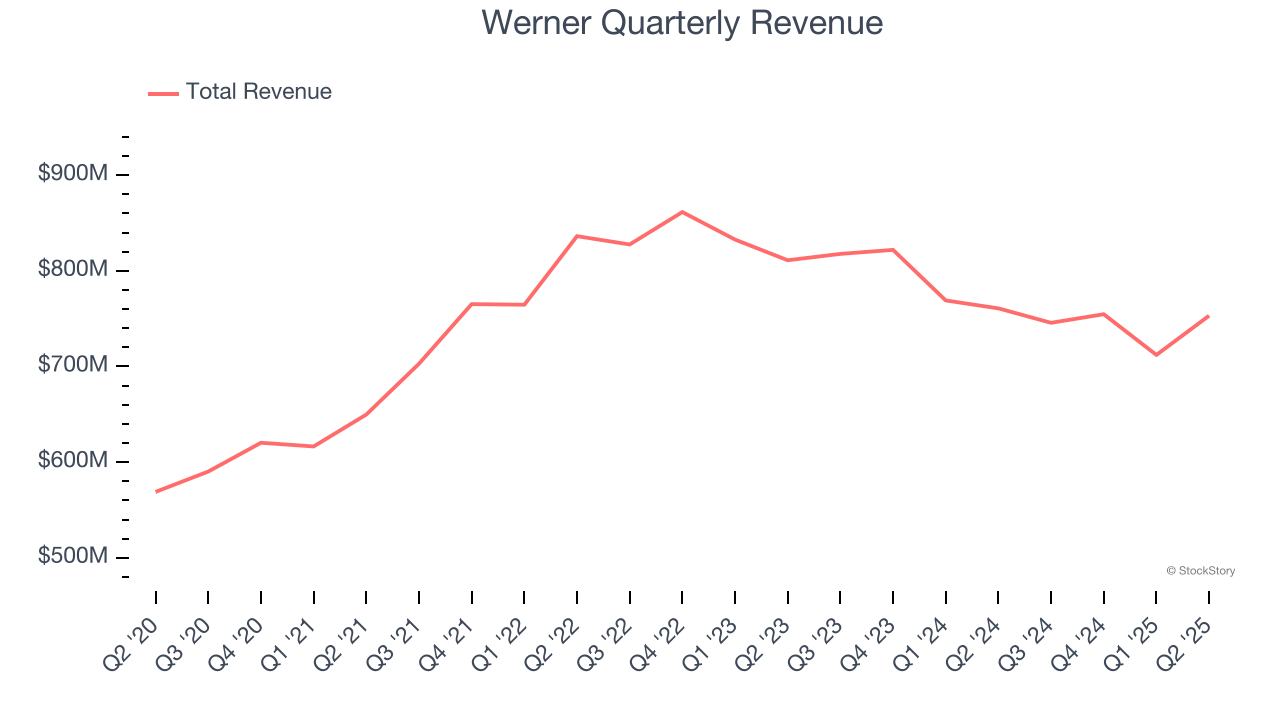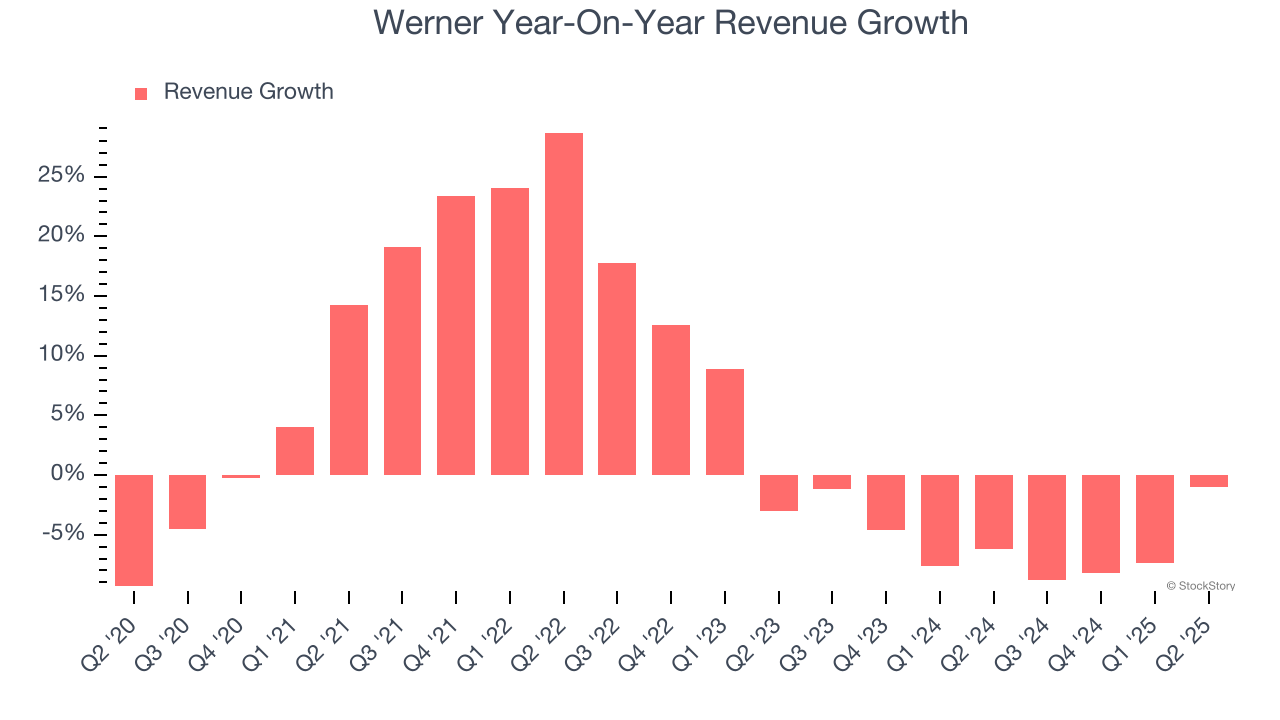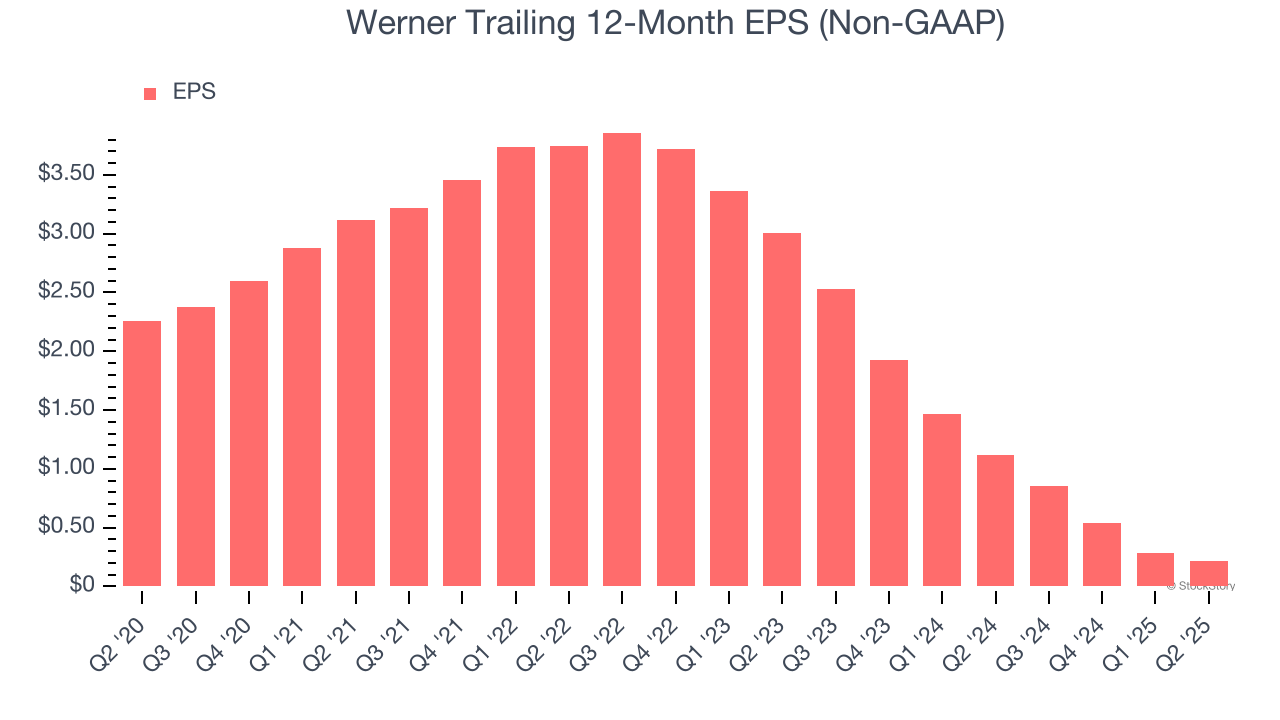
Freight delivery company Werner (NASDAQ: WERN) reported Q2 CY2025 results beating Wall Street’s revenue expectations, but sales fell by 1% year on year to $753.1 million. Its non-GAAP profit of $0.11 per share was significantly above analysts’ consensus estimates.
Is now the time to buy Werner? Find out by accessing our full research report, it’s free.
Werner (WERN) Q2 CY2025 Highlights:
- Revenue: $753.1 million vs analyst estimates of $731.4 million (1% year-on-year decline, 3% beat)
- Adjusted EPS: $0.11 vs analyst estimates of $0.05 (significant beat)
- Adjusted EBITDA: $137.1 million vs analyst estimates of $82.52 million (18.2% margin, 66.1% beat)
- Operating Margin: 8.8%, up from 2.6% in the same quarter last year
- Free Cash Flow Margin: 14.8%, up from 1.3% in the same quarter last year
- Market Capitalization: $1.77 billion
Company Overview
Conducting business in over a 100 countries, Werner (NASDAQ: WERN) offers full-truckload, less-than-truckload, and intermodal delivery services.
Revenue Growth
A company’s long-term sales performance can indicate its overall quality. Any business can put up a good quarter or two, but many enduring ones grow for years. Over the last five years, Werner grew its sales at a sluggish 4.3% compounded annual growth rate. This fell short of our benchmark for the industrials sector and is a rough starting point for our analysis.

Long-term growth is the most important, but within industrials, a half-decade historical view may miss new industry trends or demand cycles. Werner’s performance shows it grew in the past but relinquished its gains over the last two years, as its revenue fell by 5.7% annually. Werner isn’t alone in its struggles as the Ground Transportation industry experienced a cyclical downturn, with many similar businesses observing lower sales at this time. 
Werner also breaks out the revenue for its most important segments, Truckload Transportation and Logistics, which are 68.7% and 29.4% of revenue. Over the last two years, Werner’s Truckload Transportation revenue (deliveries made with Werner's fleet) averaged 7.4% year-on-year declines while its Logistics revenue (brokered deliveries using third-party fleets) was flat.
This quarter, Werner’s revenue fell by 1% year on year to $753.1 million but beat Wall Street’s estimates by 3%.
Looking ahead, sell-side analysts expect revenue to grow 2.6% over the next 12 months. While this projection suggests its newer products and services will spur better top-line performance, it is still below average for the sector.
Here at StockStory, we certainly understand the potential of thematic investing. Diverse winners from Microsoft (MSFT) to Alphabet (GOOG), Coca-Cola (KO) to Monster Beverage (MNST) could all have been identified as promising growth stories with a megatrend driving the growth. So, in that spirit, we’ve identified a relatively under-the-radar profitable growth stock benefiting from the rise of AI, available to you FREE via this link.
Operating Margin
Werner was profitable over the last five years but held back by its large cost base. Its average operating margin of 7.2% was weak for an industrials business. This result isn’t too surprising given its low gross margin as a starting point.
Looking at the trend in its profitability, Werner’s operating margin decreased by 8.3 percentage points over the last five years. This raises questions about the company’s expense base because its revenue growth should have given it leverage on its fixed costs, resulting in better economies of scale and profitability. We’ve noticed many Ground Transportation companies also saw their margins fall (along with revenue, as mentioned above) because the cycle turned in the wrong direction, but Werner’s performance was poor no matter how you look at it. It shows that costs were rising and it couldn’t pass them onto its customers.

In Q2, Werner generated an operating margin profit margin of 8.8%, up 6.2 percentage points year on year. The increase was driven by stronger leverage on its cost of sales (not higher efficiency with its operating expenses), as indicated by its larger rise in gross margin.
Earnings Per Share
Revenue trends explain a company’s historical growth, but the long-term change in earnings per share (EPS) points to the profitability of that growth – for example, a company could inflate its sales through excessive spending on advertising and promotions.
Sadly for Werner, its EPS declined by 37.2% annually over the last five years while its revenue grew by 4.3%. This tells us the company became less profitable on a per-share basis as it expanded due to non-fundamental factors such as interest expenses and taxes.

We can take a deeper look into Werner’s earnings to better understand the drivers of its performance. As we mentioned earlier, Werner’s operating margin expanded this quarter but declined by 8.3 percentage points over the last five years. This was the most relevant factor (aside from the revenue impact) behind its lower earnings; interest expenses and taxes can also affect EPS but don’t tell us as much about a company’s fundamentals.
Like with revenue, we analyze EPS over a shorter period to see if we are missing a change in the business.
For Werner, its two-year annual EPS declines of 73% show it’s continued to underperform. These results were bad no matter how you slice the data.
In Q2, Werner reported EPS at $0.11, down from $0.17 in the same quarter last year. Despite falling year on year, this print easily cleared analysts’ estimates. Over the next 12 months, Wall Street expects Werner’s full-year EPS of $0.22 to grow 259%.
Key Takeaways from Werner’s Q2 Results
We were impressed by how significantly Werner blew past analysts’ EPS expectations this quarter. We were also excited its EBITDA outperformed Wall Street’s estimates by a wide margin. Zooming out, we think this was a solid print. The stock traded up 2.5% to $28.51 immediately after reporting.
Werner put up rock-solid earnings, but one quarter doesn’t necessarily make the stock a buy. Let’s see if this is a good investment. If you’re making that decision, you should consider the bigger picture of valuation, business qualities, as well as the latest earnings. We cover that in our actionable full research report which you can read here, it’s free.

















